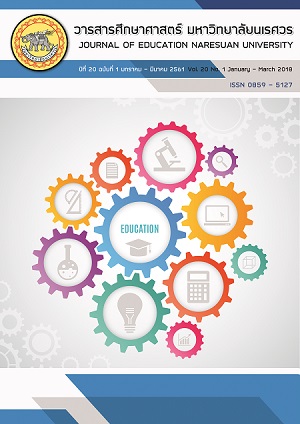ความสัมพันธ์ระหว่างคุณภาพชีวิตในการทำงานกับความผูกพันต่อองค์การ ของครูในสถานศึกษาขั้นพื้นฐานจังหวัดตาก; THE RELATIONSHIP BETWEEN QUALITY OF WORKING LIFE AND ORGANIZATIONAL COMMITMENT OF TEACHERS IN BASIC EDUCATION SCHOOLS IN TAK PROVINCE
Main Article Content
Abstract
การวิจัยครั้งนี้มีวัตถุประสงค์เพื่อ 1) ศึกษาระดับคุณภาพชีวิตในการทำงานของครูในสถานศึกษาขั้นพื้นฐาน จังหวัดตาก 2) ศึกษาระดับความผูกพันต่อองค์การของครูในสถานศึกษาขั้นพื้นฐาน จังหวัดตาก และ 3) ศึกษาความสัมพันธ์ระหว่างคุณภาพชีวิตในการทำงานกับความผูกพันต่อองค์การของครูในสถานศึกษาขั้นพื้นฐาน จังหวัดตาก กลุ่มตัวอย่าง คือ ครูในสถานศึกษาขั้นพื้นฐาน จังหวัดตาก จำนวน 338 คน เครื่องมือที่ใช้ในการวิจัยเป็นแบบสอบถามชนิดมาตราส่วนประมาณค่า แบบสอบถามประกอบด้วยข้อมูลคุณภาพชีวิตในการทำงานและข้อมูลความผูกพันต่อองค์การ ซึ่งมีค่าความเที่ยงเท่ากับ 0.91 และ 0.86 ตามลำดับ สถิติที่ใช้ในการวิเคราะห์ข้อมูลได้แก่ ความถี่ ค่าร้อยละ ค่าเฉลี่ย ส่วนเบี่ยงเบนมาตรฐาน และค่าสัมประสิทธิ์สหสัมพันธ์แบบเพียร์สัน ผลการวิจัยปรากฏ ดังนี้ 1) ระดับคุณภาพชีวิตในการทำงานของครูในสถานศึกษาขั้นพื้นฐาน จังหวัดตาก โดยรวมอยู่ในระดับมาก 2) ระดับความผูกพันต่อองค์การของครูในสถานศึกษาขั้นพื้นฐาน จังหวัดตาก โดยรวมอยู่ในระดับมาก และ 3) ความสัมพันธ์ระหว่างคุณภาพชีวิตในการทำงานกับความผูกพันต่อองค์การของครูในสถานศึกษาขั้นพื้นฐาน จังหวัดตาก มีความสัมพันธ์เชิงบวกในระดับสูงอย่างมีนัยสำคัญทางสถิติที่ระดับ 0.01
THE RELATIONSHIP BETWEEN QUALITY OF WORKING LIFE AND ORGANIZATIONAL COMMITMENT OF TEACHERS IN BASIC EDUCATION SCHOOLS IN TAK PROVINCE
The purposes of this research were 1) to study the level of quality of working life of teachers in basic education schools in Tak Province, 2) to study the level of organizational commitment of teachers in basic education schools in Tak Province, and 3) to explore the relationship between the quality of working life and organizational commitment of teachers in basic education schools in Tak Province. The sample consisted of 338 teachers in basic education schools in Tak Province. The employed research instrument was a rating scale questionnaire, dealing with data on quality of working life of teachers and organizational commitment of teachers, with reliability coefficient of 0.91 and 0.86, respectively. Statistics employed for data analysis were the frequency, percentage, mean, standard deviation, and Pearson’s Product-moment Correlation Coefficient. The research findings were as follows: 1) the overall quality of working life of teachers in basic education schools in Tak Province was at the high level, 2) the overall organizational commitment of teachers in basic education schools in Tak Province was at the high level, and 3) The relationship between the quality of working life and organizational commitment of teachers in basic education schools in Tak Province was positive at the high level and statistically significant at 0.01 level.
Article Details
The owner of the article does not copy or violate any of its copyright. If any copyright infringement occurs or prosecution, in any case, the Editorial Board is not involved in all the rights to the owner of the article to be performed.
References
Ditcharoen, K. (1995). Quality of life in workplace of middle class employees in medium scale industry in Bangkok (Master thesis). Bangkok: National Institute of Development Administration. (in Thai)
Eisenberger, R., et al. (1990). Perceived organization support and employee diligence, commitment, and innovation. Journal of Applied Psychology, 75, 11.
Jantarakul, J. (2002). Relationship between quality of life in workplace and work efficiency:
A case study of Advanced Info Service Company in Bangkok (Master thesis). Bangkok: Suan Dusit Rajabhat University. (in Thai)
Kaewpom, P. (2012). Quality of life in workplace of teachers under Chantaburi primary educational service office 2 in amphoe Pongnamron (Master thesis). Chonburi: Burapha University. (in Thai)
Marsh, Robert, & Mannari, Hiroshi. (1979). Organizational commitment and turnover: A prediction study. Administrative Science Quarterly, 22, 8.
Moorman, R. (1991). Relationship between organization justice and citizenship behavior: Daffiness perceptions influence employee citizenship .Journal of Applied Psychology, 29 (30), 845.
Mitchell. Terrence R., & Larson, Jane R., Jr. (1987). People in Organization: An Introduction to Organization Behavior (3rd ed.). Singapore: McGraw-Hill international Editions.
Muchinsky, P. M. (1996). Psychology applied to work (5th ed.). New York: Books Cole Publishing Company.
Phung-ngern, C. (2013). Quality of life in workplace of teachers under Pattaya education office in Chonburi province (Master thesis). Chonburi: Burapha University. (in Thai)
Porter, L. W., Lawer, Edward E., & Hackman, Richard M. (1975). Behavior in organization. New York: McGraw-Hill.
Rattanakot, I. (2008). The relationship between demographic factors and quality of working of life and organization commitment of supporting staff at Prince of Songkla University, Pattani Campus (Research report). Pattani: Prince of Songkla University, Pattani Campus. (in Thai)
Rayubsri, W. (2003). Quality of life in workplace of teachers in industrial area: a case study of office of the primary education in Samut Prakan province (Master thesis). Bangkok: Srinakharinwirot University.
(in Thai)
Richard E. Walton. (1973). Quality of Working Life: What is It? Stone Management Review, 15 (September), 12-16.
Srijumnong, J. (2006). A study of factors affecting the quality of work life of teachers under Loei education service area office (Master thesis). Loei: Loei Rajabhat University. (in Thai)
Steers, R. M. (1977). Antecedents and outcomes of organizational commitment. Administrative Science Quarterly, 22, 46-56.
Thongthavee, W. (2001). Factors Related to the Commitment of Praboromarajchanok Institute Personnel (Master thesis). Bangkok: Kasetsart University. (in Thai)


